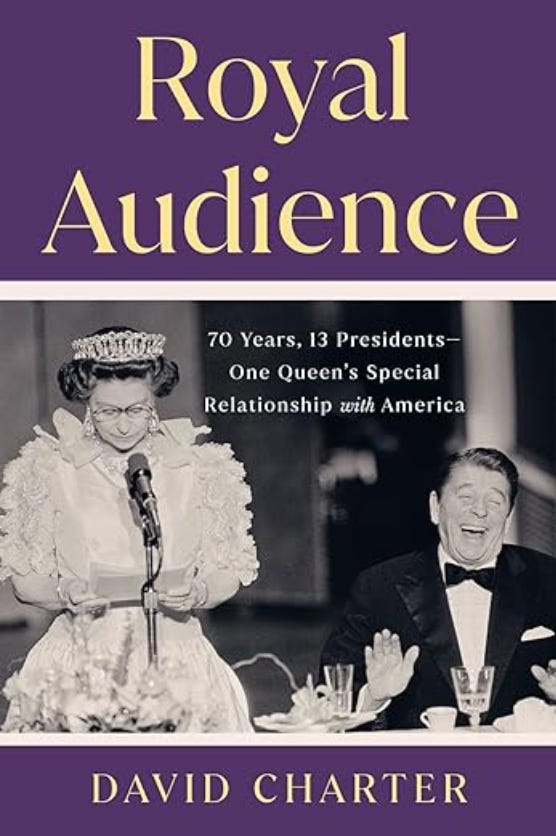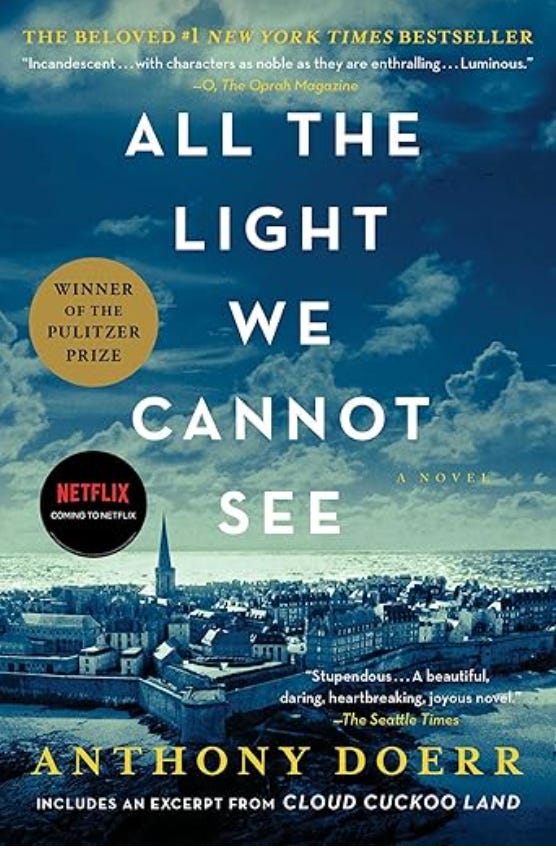
The reviews for March 3 include Queen Elizabeth’s special relationship with America in “Royal Audience” and Pulitzer Prize winning WWII novel “All the Light We Cannot See.”
ROYAL AUDIENCE
by David Charter

Published by G. P. Putnam’s Sons (March 5, 2024)
Hardcover $30.00
Audiobook $14.59
Reviewed by Penny A Parrish
Seventy years on the throne. Thirteen Presidents. The amazing relationship between Queen Elizabeth and the United States is detailed in this new book.
Her first meeting occurred when she was still a Princess. In 1951, she became the first member of the royal family to fly across the Atlantic. After a multi-day visit to Canada, Elizabeth and husband Prince Philip flew to Washington where they met the Trumans. By the time of her next visit in 1957, she was Queen and with President Eisenhower. She participated in the 350th anniversary of the founding of Jamestown. In her 1976 visit, she had the delicate task of congratulating the US for winning a war that her nation lost.
In 1944, Winston Churchill referred to the “Special Relationship” between Britain and the United States, and the need for it to endure through future generations. That term was used in many of the speeches and toasts, heavily quoted here, given by the Queen and various Presidents. There are details not only about the visits, the banquets, and the parades but also about the politics affecting both countries. Britain was losing Commonwealth nations and facing economic hardships from wars to Brexit. Though a figurehead in her own country, she wielded enormous influence through her friendships and consistency in dealing with affairs of state and international relationships.
The Queen appeared to have deep friendships with four Presidents in particular. With Eisenhower, she shared the events and then memories of WWII. With Reagan, a love for horses and a sense of humor. With George H. W. Bush, a fondness for Barbara, a first lady and a mother she could identify with. And with the Obamas, a friendship that continued long after they left the White House.
There are delightful details with Prince Philip feeding the corgis under the table; with tall President H. W. Bush not pulling out a step stool for the Queen, so when she spoke at a news conference, reporters could only see her hat floating above the microphone; with Jimmy Carter (supposedly) kissing the Queen Mother on the lips. Little tidbits that humanize all the characters. For me, one of the most delightful aspects of this book is the cover photo and learning how the clever photographer captured it.
The lengthy reign of Elizabeth is not likely to be repeated. In this book, readers can better understand and appreciate the impact she had on “both sides of the pond.”
Penny A Parrish is a long-time book reviewer and artist. Learn more about her by visiting her page at Brush Strokes Gallery, which is in downtown Fredericksburg.

ALL THE LIGHT WE CANNOT SEE
By ANTHONY DOER

Published by Scribner (April 4, 2017)
Paperback $12.97
Audiobook $12.99
Reviewed by Vanessa Sekinger
Anthony Doerr’s All the Light We Cannot See, now a series on Netflix, follows two young characters on differing sides of WWII. Their stories develop in parallel and then intertwine as the author presents the reader with lush descriptions and difficult situations.
Marie-Laure is a young French girl who lives in Paris with her father. Their mostly idyllic existence at home and the Museum of Natural History is devastated by the Nazi takeover of France. Marie-Laure, who is blind, must leave the neighborhood she knows and travel with her father to Saint-Malo to stay with her great uncle Etienne. This difficult journey is followed by a time of Nazi occupation, rationing, uncertainty, and resistance. The contrasting plot line follows Werner, an orphan from a coal mining German town, who has a talent for fixing radios. Werner is selected for a Nazi academy where he learns about radio technology and is a part of developing a way to track resistance groups through their radio signals.
The author presents Werner and Marie-Laure as similar, they are both young people finding their way during a war, both are blind (Werner only metaphorically), and both have a love for family. The detailed descriptions create a world that feels real and ethereal. The descriptions of the bombings are vivid and striking, but they are contrasted with those of the museum, Saint-Malo, and Etienne’s house. Those have a hint of fantasy and represent safety and warmth.
Beyond their similarities, Doerr traces the paths they have taken to survive the war. Werner, at first, only wants to leave the orphanage and have other opportunities, but he slowly realizes the human cost of those opportunities. After being blocked into a basement during a bombing, he realizes how his success with the radio has caused the deaths of others. Marie-Laure describes how she survived blindness, loss of loved ones, the war, not as bravery, but as she just kept going. When they meet, Marie-Laure senses the goodness in Werner, and that meeting allows Werner to see it in himself.
The underpinning plotline of protecting a valuable jewel from being stolen by the Nazis symbolizes the daily battle for humanity during war. Doeer asks readers to consider the choices they would make when posed with the same dilemmas. Doerr’s answer is always the same – choose love, choose compassion, choose sacrifice for another – these are the ways to retain humanity. The light that we sometimes cannot see. That light is in all of us.
Vanessa Sekinger is the editor of the Books and Culture page and loves to read, spend time with family, laugh, and be outside.





